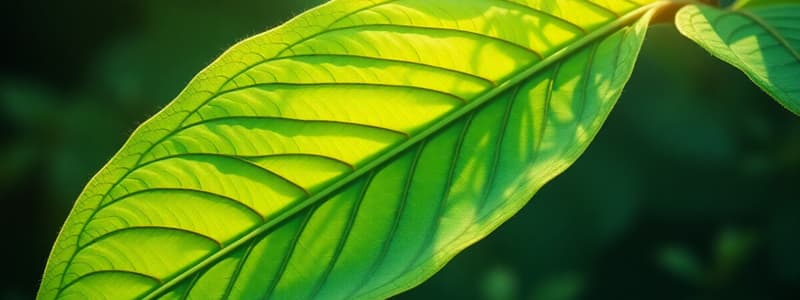Podcast
Questions and Answers
What is the primary function of the palisade layer in a leaf?
What is the primary function of the palisade layer in a leaf?
- Protection against herbivores
- Gas exchange between the leaf and environment
- Transport of water and minerals
- Light absorption for photosynthesis (correct)
Which component of the leaf is primarily responsible for transporting sugar produced during photosynthesis?
Which component of the leaf is primarily responsible for transporting sugar produced during photosynthesis?
- Phloem (correct)
- Stomata
- Cuticle
- Xylem
What role do guard cells play in the leaf structure?
What role do guard cells play in the leaf structure?
- Transport water to the leaf
- Absorb light for photosynthesis
- Provide structural support to the leaf
- Regulate the opening and closing of stomata (correct)
Which layer of the leaf is involved in gas exchange?
Which layer of the leaf is involved in gas exchange?
What is the function of the cuticle in the leaf structure?
What is the function of the cuticle in the leaf structure?
Flashcards
Cuticle
Cuticle
A waxy layer that protects the leaf from water loss and damage.
Palisade Layer
Palisade Layer
A layer of tightly packed cells containing chloroplasts for photosynthesis.
Spongy Mesophyll
Spongy Mesophyll
A layer of loosely packed cells with chloroplasts, allowing gas exchange and water storage.
Vascular Tissue
Vascular Tissue
Signup and view all the flashcards
Stomata
Stomata
Signup and view all the flashcards
Study Notes
Leaf Structure
- Light absorption occurs through the upper leaf surface
- The upper epidermis is covered by a waxy cuticle
- The upper epidermis protects the leaf from water loss and sun damage.
- The palisade layer is composed of elongated cells packed tightly together, optimized for capturing sunlight for photosynthesis.
- The spongy mesophyll is composed of loosely arranged cells, enabling gas exchange, allowing CO2 to reach the chloroplasts within the cells.
- The vascular tissue (xylem and phloem) transports water and nutrients throughout the plant.
- Xylem transports water and minerals from the roots to the leaves.
- Phloem transports sugars from the leaves to other parts of the plant.
- The lower epidermis contains stomata.
- Stomata are pores that regulate gas exchange (CO2 in, O2 out)
- Guard cells surround the stomata, controlling their opening and closing, regulating water loss and gas exchange.
Studying That Suits You
Use AI to generate personalized quizzes and flashcards to suit your learning preferences.




